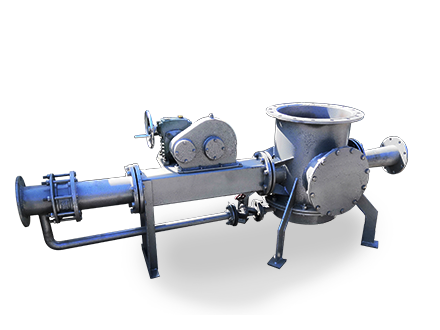 濟(jì)南鑫魯泉盛機(jī)械設(shè)備有限公司
濟(jì)南鑫魯泉盛機(jī)械設(shè)備有限公司
服務(wù)熱線:15662735099
聯(lián)系地址:山東章丘棗園經(jīng)濟(jì)開發(fā)區(qū)
在散裝物料處理領(lǐng)域,倉(cāng)泵與普通料倉(cāng)如同兩條技術(shù)分支,分別代表著“靜態(tài)存儲(chǔ)”與“動(dòng)態(tài)輸送”的哲學(xué)。盡管兩者在外觀上可能僅體現(xiàn)為金屬容器的差異,但其設(shè)計(jì)理念、功能特性與應(yīng)用場(chǎng)景卻有著本質(zhì)區(qū)別。
In the field of bulk material handling, silo pumps and ordinary silos are like two technical branches, representing the philosophy of "static storage" and "dynamic conveying" respectively. Although the two may only differ in appearance as metal containers, their design concepts, functional characteristics, and application scenarios have essential differences.
一、設(shè)計(jì)理念的“動(dòng)靜之別”
1、 The difference between dynamic and static design concepts
普通料倉(cāng)的設(shè)計(jì)遵循“重力流”原則,其核心邏輯是利用物料自重實(shí)現(xiàn)自然下料。倉(cāng)體通常采用圓錐形或矩形結(jié)構(gòu),內(nèi)部光滑無障礙,出料口設(shè)置在底部中心位置。這種設(shè)計(jì)如同一個(gè)“物料蓄水池”,通過料位計(jì)監(jiān)測(cè)庫存量,通過振動(dòng)器或破拱裝置解決架橋問題,本質(zhì)上是物料存儲(chǔ)與計(jì)量功能的延伸。
The design of ordinary silos follows the principle of "gravity flow", and its core logic is to use the self weight of materials to achieve natural feeding. The warehouse body usually adopts a conical or rectangular structure, with a smooth and unobstructed interior, and the discharge port is set at the bottom center position. This design is like a 'material reservoir', monitoring inventory levels through level gauges and solving bridging problems through vibrators or arch breaking devices. Essentially, it is an extension of material storage and metering functions.
倉(cāng)泵的設(shè)計(jì)則蘊(yùn)含“氣力輸送”的智慧。其結(jié)構(gòu)中集成進(jìn)氣閥、出料閥、流化裝置等氣動(dòng)元件,倉(cāng)體底部設(shè)計(jì)有特殊的氣室結(jié)構(gòu)。當(dāng)壓縮空氣注入時(shí),物料在氣流作用下形成“擬流體”,實(shí)現(xiàn)遠(yuǎn)距離密相輸送。這種設(shè)計(jì)如同為物料裝上“隱形傳送帶”,將存儲(chǔ)功能與輸送功能合二為一。
The design of the warehouse pump embodies the wisdom of "pneumatic conveying". The structure integrates pneumatic components such as intake valve, discharge valve, and fluidization device, and the bottom of the compartment is designed with a special air chamber structure. When compressed air is injected, the material forms a "pseudo fluid" under the action of the airflow, achieving long-distance dense phase transportation. This design is like installing an "invisible conveyor belt" on materials, combining storage and conveying functions into one.
二、功能特性的“三維對(duì)比”
2、 Three dimensional comparison of functional characteristics
1. 輸送能力:從“被動(dòng)泄流”到“主動(dòng)噴射”
1. Transport capacity: from "passive discharge" to "active injection"
普通料倉(cāng)的出料能力受限于物料安息角與倉(cāng)體錐度,當(dāng)處理粘性物料時(shí)易出現(xiàn)鼠洞、架橋現(xiàn)象。而倉(cāng)泵通過氣流對(duì)物料進(jìn)行流化處理,使粉體呈現(xiàn)“沸騰”狀態(tài),輸送濃度可達(dá)普通氣力輸送的2-3倍,輸送距離突破千米級(jí)大關(guān)。
The discharge capacity of ordinary silos is limited by the angle of rest of the material and the taper of the silo body, which can easily lead to rodent holes and bridging when handling viscous materials. And the warehouse pump fluidized the material through airflow, making the powder present a "boiling" state, and the conveying concentration can reach 2-3 times that of ordinary pneumatic conveying, with a conveying distance exceeding the kilometer level.
2. 密封性能:從“開放式”到“全封閉”
2. Sealing performance: from "open" to "fully enclosed"
普通料倉(cāng)在出料過程中易產(chǎn)生揚(yáng)塵,需配套除塵器進(jìn)行二次處理。倉(cāng)泵采用正壓輸送方式,整個(gè)系統(tǒng)處于密閉狀態(tài),輸送管道內(nèi)壓力可達(dá)0.6MPa,徹底杜絕物料泄漏風(fēng)險(xiǎn),特別適用于有毒、易燃物料的處理。
Ordinary silos are prone to generating dust during the discharge process and require secondary treatment with a dust collector. The warehouse pump adopts positive pressure conveying method, and the entire system is in a closed state. The pressure inside the conveying pipeline can reach 0.6MPa, completely eliminating the risk of material leakage, especially suitable for the treatment of toxic and flammable materials.
3. 智能控制:從“機(jī)械式”到“自適應(yīng)”
3. Intelligent control: from "mechanical" to "adaptive"
現(xiàn)代倉(cāng)泵已實(shí)現(xiàn)全流程自動(dòng)化控制:
Modern warehouse pumps have achieved full process automation control:
流化狀態(tài)監(jiān)測(cè):通過壓力傳感器實(shí)時(shí)感知物料流化程度,自動(dòng)調(diào)節(jié)進(jìn)氣量;
Fluidization status monitoring: Real time sensing of material fluidization degree through pressure sensors, automatic adjustment of intake air volume;

輸送速度優(yōu)化:根據(jù)管道壓降動(dòng)態(tài)調(diào)整輸送氣速,避免堵管風(fēng)險(xiǎn);
Optimization of conveying speed: dynamically adjust the conveying gas speed based on pipeline pressure drop to avoid the risk of pipe blockage;
能耗管理:采用變頻壓縮機(jī)與儲(chǔ)氣罐組合,實(shí)現(xiàn)按需供氣,能耗降低30%以上。
Energy consumption management: By using a combination of variable frequency compressors and gas storage tanks, on-demand gas supply can be achieved, reducing energy consumption by more than 30%.
三、應(yīng)用場(chǎng)景的“生態(tài)重構(gòu)”
3、 Ecological reconstruction of application scenarios
普通料倉(cāng)的典型應(yīng)用場(chǎng)景包括:
The typical application scenarios of ordinary silos include:
原料中轉(zhuǎn):在糧食、建材行業(yè)作為生產(chǎn)緩沖倉(cāng)使用;
Raw material transfer: used as a production buffer warehouse in the grain and building materials industries;
計(jì)量配料:通過稱重模塊實(shí)現(xiàn)配方原料的精準(zhǔn)投加;
Measuring ingredients: precise addition of formula raw materials through weighing modules;
散貨存儲(chǔ):在港口、礦山等場(chǎng)合完成大宗物料的臨時(shí)堆存。
Bulk storage: Temporary storage of bulk materials in ports, mines, and other places.
倉(cāng)泵則開辟了全新的應(yīng)用維度:
Warehouse pumps have opened up new application dimensions:
長(zhǎng)距離輸送:在電力行業(yè)實(shí)現(xiàn)省煤器灰渣的跨廠區(qū)輸送;
Long distance transportation: achieving cross plant transportation of economizer ash in the power industry;
高危物料處理:在化工領(lǐng)域完成有毒粉體的密閉轉(zhuǎn)運(yùn);
High risk material handling: Closed transportation of toxic powders in the chemical industry;
空間受限場(chǎng)景:在高層建筑中實(shí)現(xiàn)粉料的垂直提升與水平輸送。
Space constrained scenario: achieving vertical lifting and horizontal conveying of powder materials in high-rise buildings.
四、技術(shù)演進(jìn)的“分野與融合”
4、 The "division and integration" of technological evolution
隨著工業(yè)4.0的推進(jìn),兩者正在經(jīng)歷技術(shù)融合:
With the advancement of Industry 4.0, the two are undergoing technological integration:
智能料倉(cāng):在普通料倉(cāng)中集成倉(cāng)泵的流化技術(shù),通過底部氣墊破拱,將靜態(tài)存儲(chǔ)轉(zhuǎn)化為“準(zhǔn)流動(dòng)”狀態(tài);
Intelligent silo: Integrating fluidization technology with silo pumps in ordinary silos, transforming static storage into a "quasi flow" state through bottom air cushion arch breaking;
模塊化倉(cāng)泵:將大型倉(cāng)泵分解為標(biāo)準(zhǔn)單元,通過積木式組合滿足不同輸送需求;
Modular bin pump: Decompose large bin pumps into standard units and meet different conveying needs through modular combinations;
數(shù)字孿生系統(tǒng):建立物料流動(dòng)的虛擬模型,實(shí)現(xiàn)倉(cāng)泵與料倉(cāng)的協(xié)同優(yōu)化。
Digital twin system: Establish a virtual model of material flow to achieve collaborative optimization between warehouse pumps and silos.
倉(cāng)泵與普通料倉(cāng)的區(qū)別,本質(zhì)上是物料處理理念的“動(dòng)靜之辯”。前者以“氣動(dòng)學(xué)”重構(gòu)物料運(yùn)動(dòng)規(guī)律,后者以“靜力學(xué)”詮釋存儲(chǔ)哲學(xué)。在智能制造時(shí)代,兩者既保持技術(shù)分野,又呈現(xiàn)融合趨勢(shì),共同構(gòu)建起從“存”到“用”的完整物料處理生態(tài)鏈。當(dāng)一粒物料在倉(cāng)泵中化作“氣溶膠”奔向生產(chǎn)線時(shí),這場(chǎng)靜與動(dòng)的技術(shù)對(duì)話,正在重新定義工業(yè)生產(chǎn)的物流基因。
The difference between a silo pump and a regular silo is essentially a "debate between motion and stillness" in material handling concepts. The former reconstructs the laws of material motion through "aerodynamics", while the latter interprets storage philosophy through "statics". In the era of intelligent manufacturing, the two maintain technological differentiation while showing a trend of integration, jointly building a complete material processing ecosystem from "storage" to "use". When a material turns into an "aerosol" in the warehouse pump and rushes towards the production line, this static and dynamic technical dialogue is redefining the logistics genes of industrial production.
本文由倉(cāng)泵友情奉獻(xiàn).更多有關(guān)的知識(shí)請(qǐng)點(diǎn)擊:http://m.44yd.cn我們將會(huì)對(duì)您提出的疑問進(jìn)行詳細(xì)的解答,歡迎您登錄網(wǎng)站留言.
This article is a friendly contribution from the pneumatic conveying system For more information, please click: http://m.44yd.cn We will provide detailed answers to your questions. You are welcome to log in to our website and leave a message
2024 濟(jì)南鑫魯泉盛機(jī)械設(shè)備有限公司 備案號(hào):魯ICP備18012408號(hào)-3 魯公網(wǎng)安備37018102000806號(hào)

